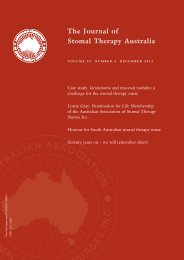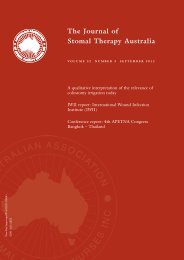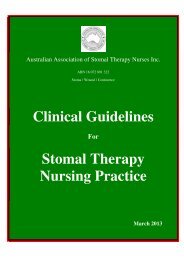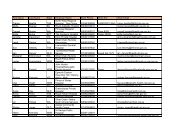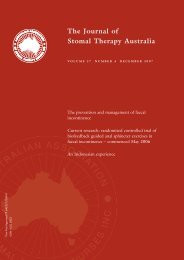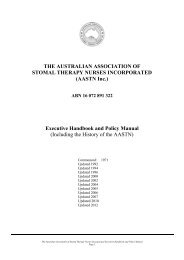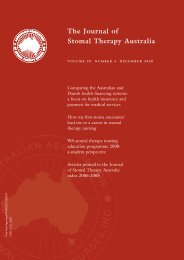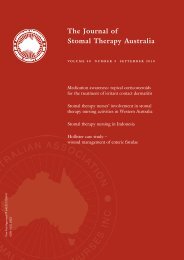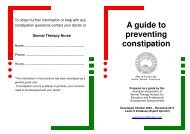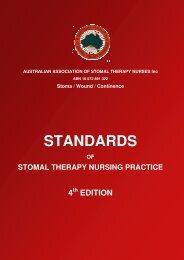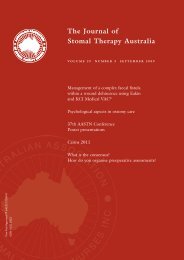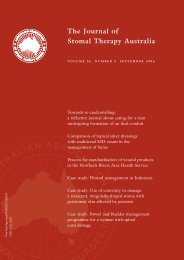JSTA December 2010 - Australian Association of Stomal Therapy ...
JSTA December 2010 - Australian Association of Stomal Therapy ...
JSTA December 2010 - Australian Association of Stomal Therapy ...
You also want an ePaper? Increase the reach of your titles
YUMPU automatically turns print PDFs into web optimized ePapers that Google loves.
Reflective essay<br />
Katie Jane Bird<br />
INTroducTIoN<br />
This reflective essay will demonstrate my journey from a<br />
beginning stomal therapist practitioner to an advanced<br />
practitioner. It will provide different examples and experiences<br />
that have been significant to my individual journey. The<br />
<strong>Australian</strong> Nursing Federation Competency Standards for the<br />
Advanced Registered Nurse 1 will be applied throughout by<br />
the competency standard identified in bold and in brackets<br />
following the related action. Each point <strong>of</strong> the competency<br />
standard will be allocated a corresponding number, for example<br />
competency one, point three will be 1.3.<br />
reflecTIve exPerIeNce<br />
I first met Mr Kat on the ward on a Sunday while I was the<br />
clinical nurse in charge <strong>of</strong> the shift. He was transferred from ICU<br />
day two post-emergency Hartman’s procedure for perforated<br />
diverticulitis. I introduced myself to the patient and then the<br />
ICU nurse handed over to me and showed me Mr Kat’s stoma.<br />
The stoma was covered in a dark red blood clot so was not<br />
visible (4.1, 4.6). On my questioning, the ICU nurse said she<br />
thought the stoma had always looked like that but she could not<br />
be sure (5.1, 6.7). The patient’s notes did not give any further<br />
information (1.1, 1.3, 1.8, 1.9, 5.1). Blackley2 states a stoma should<br />
be inspected as soon as possible after the operation to make<br />
baseline observations. This includes ensuring the colour <strong>of</strong> the<br />
stoma is bright to dark red to indicate adequate blood supply<br />
(6.2). I decided to do a closer inspection myself (7.2). Mr Kat was<br />
awake and alert so I explained my role as a clinical nurse for the<br />
ward and a stomal therapist. I asked him if I could have a better<br />
look at his stoma because <strong>of</strong> the clot and the need to check blood<br />
supply (1.10). He was happy for me to proceed. I discovered the<br />
clot would not be dislodged easily and I could still not view the<br />
stoma (1.7, 8.1). I was not happy to continue to try and remove<br />
the clot as I did not know where the blood had come from or<br />
if I would disrupt something. I did not wish to do any harm<br />
(1.6, 3.2, 3.3). I opted to ring the on-call surgical registrar for<br />
advice; coincidently the patient was on her team (6.3, 6.6). The<br />
registrar agreed it was important to view the stoma and together<br />
we removed the clot to reveal a healthy, pink, moist stoma. I<br />
informed Mr Kat <strong>of</strong> the end result and documented my actions<br />
in the progress notes.<br />
This was my first experience <strong>of</strong> dealing with an abnormality<br />
in a postoperative stoma independently. I felt a sense <strong>of</strong><br />
accomplishment that day as I realised I was able to adapt<br />
my practice and integrate the theory I had learned and prior<br />
experiences to competently and confidently advocate for my<br />
patient’s best interests (3.5).<br />
Mr Kat’s recovery started well, he was receptive to learning about<br />
his stoma and actively took part in his cares (6.6). Mr Kat chose a<br />
two-piece appliance. I chose a base plate with slight convexity, as<br />
his stoma was retracting, with a drainable bag until the output<br />
thickened. Both <strong>of</strong> these measures were working well. I was still<br />
doing most <strong>of</strong> the care with Mr Kat verbally instructing me as he<br />
watched in a mirror (6.6). One morning while the doctors were<br />
reviewing Mr Kat they came and got me to review Mr Kat’s<br />
appliance as there was a leakage issue. I discovered that one <strong>of</strong><br />
the senior nurses had removed the appliance as some leakage<br />
had occurred due to the faeces becoming more formed and<br />
pancaking under the base plate. Instead <strong>of</strong> replacing both the<br />
base plate and bag, she had placed just the bag directly over the<br />
stoma. I had assumed that the senior nurses on the ward would<br />
be familiar with a two-piece appliance. This incident showed I<br />
was wrong and needed to do a teaching session with the staff<br />
(9.1, 9.4, 9.5). I approached the nurse unit manager (NUM) <strong>of</strong><br />
the ward and explained that I would like to do an in-service<br />
and the reason why. She agreed and we made an appropriate<br />
time and I did it the following afternoon after the nurses had<br />
handover (13.1, 13.2, 14.2). I chose this time so I would have as<br />
many staff present as possible. There was a good mix <strong>of</strong> junior<br />
and senior staff. I took along different stomal appliances and<br />
showed them how they worked and let them have a play. I<br />
asked that they share the information with staff who were not<br />
present and reminded them to involve the patient with their<br />
stomal care. I asked if they had ay questions and let them know<br />
I was always available for support (11.2, 11.3, 15.1). The session<br />
took approximately five minutes and I feel it was effective as a<br />
repeat incident has not occurred again. Feedback from the staff<br />
was positive (9.6). As Mr Kat had chosen his appliance I started<br />
to prepare him for discharge from the stomal perspective. While<br />
I was filling out the forms for him to join the Stoma <strong>Association</strong>,<br />
I discovered he did not have a Medicare card or health insurance<br />
and was waiting to apply for permanent residency. Mr Kat and<br />
his wife were from South Africa. This was all unfamiliar ground<br />
for me so I started to figure out what I could do and what<br />
implications there were going to be for Mr Kat.<br />
The first thing I did was ring the Stoma <strong>Association</strong> (5.1, 5.2,<br />
5.3, 7.28.1). They told me Mr Kat would need to get his stomal<br />
supplies directly from the company and pay for them himself.<br />
I then rang the company <strong>of</strong> his appliance and they gave me<br />
prices and a sales phone number for Mr Kat to call for ordering.<br />
They also told me about a sample pack <strong>of</strong> the chosen appliance<br />
that I could get for Mr Kat free <strong>of</strong> charge so I organised that. I<br />
relayed all this information to Mr Kat and asked his permission<br />
to contact the social worker, which he agreed to (6.6). I rang the<br />
social worker who saw Mr Kat and his wife the next day and<br />
throughout the rest <strong>of</strong> his hospital stay. I continued to liaise<br />
with the social worker and in the process learnt much about<br />
the finances <strong>of</strong> staying in hospital (5.1, 5.2, 5.3, 5.4, 5.5, 5.6, 5.7,<br />
6.3, 8.1). Because Mr Kat ended up having an extended stay, I<br />
continued to use the stomal department’s stock and organised<br />
that on discharge I would give him additional stock to take<br />
home (7.1). Because the appliance Mr Kat had chosen was<br />
working so well and he was happy with it, it did not occur to me<br />
that I should consider looking at a more cost-effective appliance.<br />
When the stomal therapist nurse took over Mr Kat’s care she<br />
did change his appliance purely for the reduction in cost. On<br />
reflection it reminds me to think outside the box.<br />
Journal <strong>of</strong> <strong>Stomal</strong> therapy australia – Volume 30 Number 4 17



